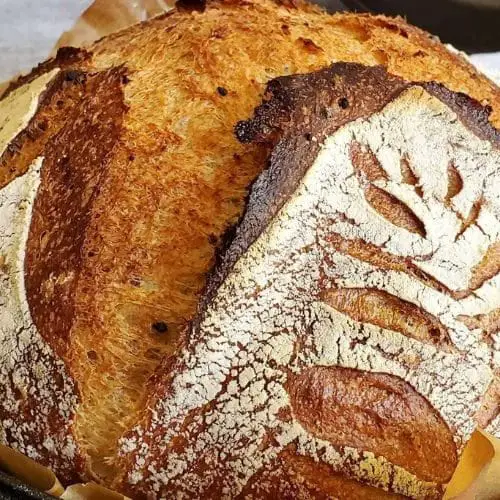
Cracker Barrel Sourdough Bread
This Cracker Barrel Sourdough Bread Recipe brings the beloved tangy, chewy, and crispy artisan-style bread straight to your kitchen. Made with a natural sourdough starter, this recipe takes time but delivers a flavorful, bakery-quality loaf with a golden crust and soft interior. Perfect for sandwiches, toast, or simply enjoying with butter, this homemade sourdough is well worth the effort!Nutrition Facts (Per Serving)Calories: 160, Total Fat: 2g, Saturated Fat: 0.3g, Cholesterol: 0mg, Sodium: 220mg, Total Carbohydrates: 30g, Dietary Fiber: 1.5g, Sugars: 1g, Protein: 4g, Iron: 8% DV, Calcium: 1% DV, Potassium: 45mgEstimated based on one serving (assuming 1 servings per batch)
Equipment
- Large mixing bowl – For mixing and fermenting the dough.
- Measuring cups and spoons – To ensure accurate ingredient measurements.
- Digital kitchen scale (optional but recommended) – For precise flour and water ratios.
- Dough scraper or spatula – Helps in mixing and handling sticky dough.
- Clean kitchen towel or plastic wrap – To cover the dough during fermentation.
- Proofing basket or bowl – For shaping and proofing the dough.
- Dutch oven or baking stone – Retains heat and creates steam for a crispy crust.
- Sharp knife or bread lame – Used for scoring the dough before baking.
- Cooling rack – Allows the bread to cool properly after baking.
Ingredients
For the Sourdough Starter (If You Don’t Have One Already)
- 1 cup bread or all-purpose flour
- ½ cup filtered water
For the Bread Dough
- 1 cup active sourdough starter
- 4 cups bread flour
- 1 ½ cups warm water
- 2 teaspoons salt
- 1 tablespoon sugar optional, for a hint of sweetness
- 1 tablespoon olive oil or melted butter
Instructions
Step 1: Prepare the Sourdough Starter (If Needed)
- In a clean jar, mix 1 cup flour and ½ cup filtered water. Stir well and loosely cover.
- Feed the starter daily with equal parts flour and water for 5–7 days until bubbly and tangy.
Step 2: Mix the Dough
- In a large mixing bowl, combine 1 cup active sourdough starter and 1 ½ cups warm water. Stir until mixed.
- Add 4 cups bread flour, 2 teaspoons salt, and 1 tablespoon sugar (if using). Mix until a shaggy dough forms.
- Cover the bowl with a damp towel and let it rest for 30 minutes to allow the flour to hydrate.
Step 3: Knead and Strengthen the Dough
- Knead the dough on a floured surface for 8–10 minutes until smooth.
- Alternatively, use the stretch and fold method—every 30 minutes for 2 hours, fold the dough over itself to develop gluten.
Step 4: Bulk Fermentation (First Rise)
- Place the dough in a greased bowl, cover, and let it rise at room temperature for 8–12 hours (overnight) until doubled in size.
Step 5: Shape the Dough
- Lightly flour a surface and turn out the dough.
- Gently shape it into a round or oval loaf, taking care not to deflate too much air.
- Place it in a floured proofing basket or bowl.
Step 6: Final Proof (Second Rise)
- Cover the dough and let it rise for another 2–4 hours at room temperature or overnight in the fridge.
- When ready to bake, the dough should pass the poke test—a pressed finger indentation should spring back slowly.
Step 7: Bake the Bread
- Preheat your oven to 450°F (230°C) and place a Dutch oven or baking stone inside to heat up.
- Carefully place the dough into the preheated Dutch oven, score the top, and cover.
- Bake covered for 25 minutes, then remove the lid and bake uncovered for 10–15 minutes until golden brown.
- The bread is done when it sounds hollow when tapped on the bottom.
Step 8: Cool and Serve
- Transfer the bread to a wire rack and let it cool for at least 1 hour before slicing.
- Enjoy fresh, toasted, or with your favorite toppings!
Notes
- Flour Choice: Bread flour gives the best structure, but a mix of bread and whole wheat flour adds extra flavor.
- For a More Tangy Flavor: Let the final proof happen in the fridge overnight.
- No Dutch Oven? Bake on a preheated baking stone and place a pan of boiling water in the oven for steam.
- Storage: Keep at room temperature for 2–3 days or freeze slices for longer storage.
- Troubleshooting: If your bread is dense, check that your starter is active and that the dough is proofed enough before baking.